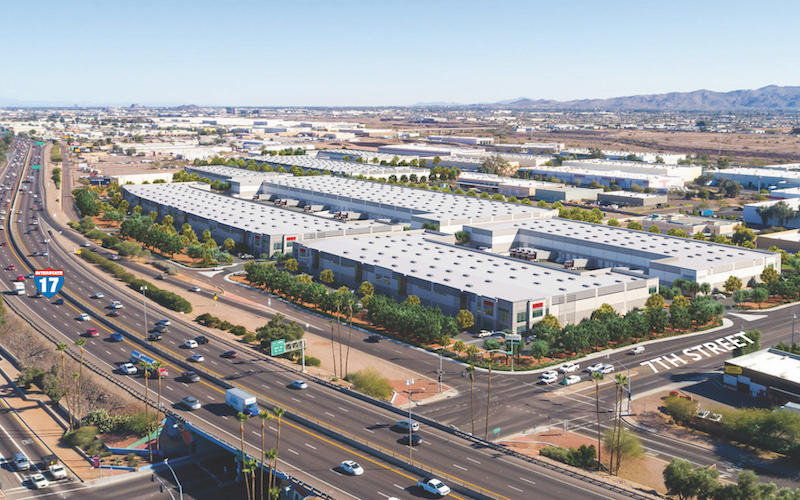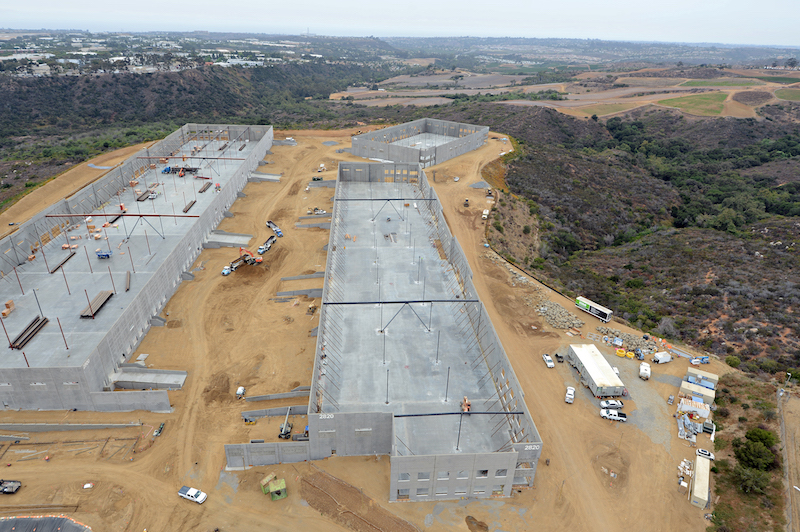As ecommerce assumes a more dominant role in retailing, logistics and distribution centers in support of ecommerce warehousing and delivery are springing up across the country.
For example, Verst Logistics in June opened a nearly 400,000-sf ecommerce fulfillment center in Hebron, Ky., near the Greater Cincinnati Northern Kentucky International Airport. This DC will allow Verst to distribute products to about 85% of the continental U.S. within 48 hours, says Dean Hoerlin, Verst’s Vice President of Fulfillment and Distribution.
Capital Development Partners and Greenfield Partners broke ground last month on a 2.3-million-sf, $125 million logistics center located on 197 acres in Pooler, Ga., 10 miles from the Port of Savannah. The first of two buildings is set to open next April, and the two buildings will have transload capacities and be able to store more than 2,000 containers.
Also last month, construction began on the 401,577-sf Oakdale Logistics Center on 24 acres in the Dallas suburb of Grand Prairie, Texas, marking the third such development in the Dallas-Fort Worth metroplex between CT (a real estate investment firm) and the developer Port Logistics Realty.
“The primary focus of CT’s growth strategy is to develop, own and manage a portfolio of logistics projects in high demand Tier 1 markets nationwide,” says James Watson, managing partner with CT, which recently announced the development of 1.34 million sf of large-scale distribution buildings in greater Chicago.
CT also is developing logistics centers in northern California, Atlanta, and New Jersey, and its current property holdings could support the addition of 15 million sf of industrial buildings over the next five to seven years.
The Commerce Department estimates that last year consumers spent $453.5 billion for online purchases, a 16% increase over 2016. Some market watchers see ecommerce rising to nearly 14% of total retail sales by 2021, from around 10% this year.
These expanding online purchasing activities among consumers are propelling industrial construction, and presenting fertile opportunities for AEC firms in this sector.
This week, Prologis, which specializes in logistics real estate, announced its selection of Graycor Construction as GC for its I-17 Logistics Center-Phase 1, a Class A development on 25 infill acres in Phoenix that will consist of four buildings totaling 558,712 sf. This development will replace 20 outmoded buildings that were recently demolished. Completion of Phase 1 is scheduled for first quarter of 2019.

A rendering of the Prologis I-17 Logistics Center-Phase I, a 558,712-sf complex that will open in Phoenix in the fall of next year. Image: Prologis
Clayco provided construction services for the $300 million 856,000-sf Amazon Fulfillment Center in Kansas City, which opened last August and was assembled using tilt-up concrete panels and structural steel. This four-floor Center has 2.3 million sf of usable space, and employs more than 2,000 full-time workers.
Clayco has built other warehouses for Amazon in Indiana, Virginia, and New Jersey, and has an 850,000-sf facility under construction in Chicago.
Last August, Ryan Companies closed on a 25.9-acre site in Carlsbad, Calif., where it is building on spec the Pacific Vista Commercial Center, a three-building, 411,000-sf logistics/distribution center located within the Carlsbad Oaks North Business Park. Ware Malcomb provided design and architectural services. SB&O provided civil engineering and storm water design services.
Chris Wood, President of Ryan Companies’ West Region, tells BD+C that this complex should be completed by October. Ryan has already secured a 10-year lease agreement with the Center’s first tenant, the storage provider PODS, which will lease Building B. Wood says it is likely that the entire complex will be leased by three to five tenants.
Inland Empire can’t get enough warehouse space
Ryan Companies is building into a market where demand for warehouse and logistical space seems insatiable. Wood says that, as of the third quarter of 2017, there were nearly 540 million sf of logistics/warehouse buildings in California’s Riverside and San Bernardino counties. For the past several years, the Inland Empire has been adding between 20 million and 25 million sf annually.
JLL estimated that in the 12 months ended December 2017, 43.5% of leasing activities for facilities larger than 50,000 sf came from ecommerce tenants. JLL also estimated at the time that there were 24 million sf of new warehouse space under construction In the Inland Empire, where the vacancy rate was 3.5% and rents averaged 53 cents per sf.
Pacific Vista Commercial Center, says Wood, is one of the first buildings that are being constructed under Carlsbad’s Climate Action Plan, which dates back to 2015, and whose goal is to reduce greenhouse gases to meet California’s mandated targets.
Among the facility’s innovative features is a 0.915-MW photovoltaic rooftop solar system that is allocated for each building that’s designed with its own substation. The PV array is set up to offset 50% of a tenant’s average utility usage, and the lease puts the system in each tenant’s name for metering purposes and so the tenant can reap the full benefits of the solar array’s energy output.
The Center will also offer 24 electric vehicle charging stations, as mandated by the Action Plan. There are 1.77 total parking stalls for every 1,000 sf of warehouse space in the Center.
Wood says Ryan Companies, which has been building industrial facilities for years, embraced Carlsbad’s green requirements. The Center was pre-certified LEED for core and shell, and Wood says it should achieve a Silver certification at a minimum.

The 26-acre Pacific Vista Commercial Center will include segregated vehicular and trucking access points and lanes that run between the buildings. PODS, the storage supplier, is the Center's first tenant, having agreed to a 10-year lease of Building B (top right). Image: Ryan Companies
Robust tenant amenities
Greenness aside, Wood says the key leasing points of this Class A facility are its functionality, location (near the Pacific Ocean), and its flexibility.
The Center will include completely segregated vehicular and trucking access points within the open area that runs between the three buildings. It will offer one dock door position for every 4,372 sf of warehouse space, and 32 ft minimum clear heights to maximize interior cubic storage capacity.
The Center’s tenant amenities include six separate outdoor employee areas with views of the surrounding open space and ocean, a centralized food truck location, sand volleyball court, bocce ball court, and a secured bicycle storage area for 35 bikes.
This $67 million project is a joint venture between Ryan Companies and Deutsche Asset Management’s DWS/RREEF Property Trust division. The partners have another joint venture spec project in the works in Poway, Calif., a 530,000-sf logistics center with two buildings that is scheduled to break ground in November.
Related Stories
| May 22, 2014
Facebook, Telus push the limits of energy efficiency with new data centers
Building Teams are employing a range of creative solutions—from evaporative cooling to novel hot/cold-aisle configurations to heat recovery schemes—in an effort to slash energy and water demand.
| May 22, 2014
7 ways it pays to use BIM for data centers
Here’s where AEC firms and owners are getting the most bang for the buck when using BIM/VDC to coordinate data center projects.
| May 22, 2014
Big Data meets data centers – What the coming DCIM boom means to owners and Building Teams
The demand for sophisticated facility monitoring solutions has spurred a new market segment—data center infrastructure management (DCIM)—that is likely to impact the way data center projects are planned, designed, built, and operated.
| May 20, 2014
Kinetic Architecture: New book explores innovations in active façades
The book, co-authored by Arup's Russell Fortmeyer, illustrates the various ways architects, consultants, and engineers approach energy and comfort by manipulating air, water, and light through the layers of passive and active building envelope systems.
| May 19, 2014
What can architects learn from nature’s 3.8 billion years of experience?
In a new report, HOK and Biomimicry 3.8 partnered to study how lessons from the temperate broadleaf forest biome, which houses many of the world’s largest population centers, can inform the design of the built environment.
| May 13, 2014
19 industry groups team to promote resilient planning and building materials
The industry associations, with more than 700,000 members generating almost $1 trillion in GDP, have issued a joint statement on resilience, pushing design and building solutions for disaster mitigation.
| May 11, 2014
Final call for entries: 2014 Giants 300 survey
BD+C's 2014 Giants 300 survey forms are due Wednesday, May 21. Survey results will be published in our July 2014 issue. The annual Giants 300 Report ranks the top AEC firms in commercial construction, by revenue.
| Apr 29, 2014
Best of Canada: 12 projects nab nation's top architectural prize [slideshow]
The conversion of a Mies van der Rohe-designed gas station and North Vancouver City Hall are among the recently completed projects to win the 2014 Governor General's Medal in Architecture.
| Apr 29, 2014
USGBC launches real-time green building data dashboard
The online data visualization resource highlights green building data for each state and Washington, D.C.
| Apr 9, 2014
Steel decks: 11 tips for their proper use | BD+C
Building Teams have been using steel decks with proven success for 75 years. Building Design+Construction consulted with technical experts from the Steel Deck Institute and the deck manufacturing industry for their advice on how best to use steel decking.
















